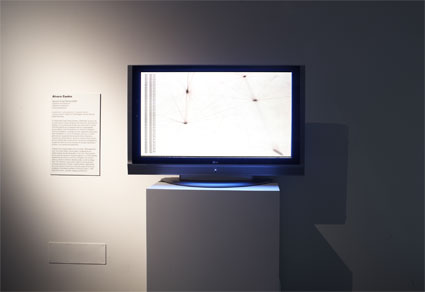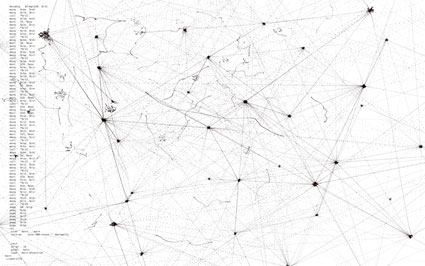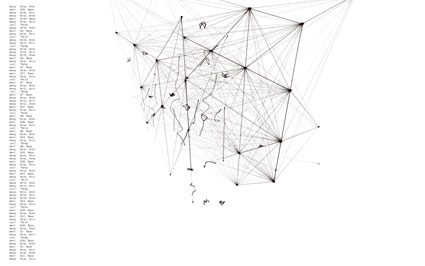Yet another project i liked at the exhibition Banquete_nodos y redes which is currently running at LABoral Art and Industrial Creation Centre in Gijón, Spain.
Vacuum Virtual Machine nevertheless required me to sit down and read carefully (twice, at least twice) what it is about.
This graphic software explores and visualizes the changing reticular self-organization of atoms and molecules. The graphics are the external expression of a virtual machine. Approaching the concept of artificial intelligence, this artefact works tirelessly to develop codes in order to change himself.
 Image courtesy of LABoral Centro de Arte y Creación Industrial
Image courtesy of LABoral Centro de Arte y Creación Industrial
The software is a generative model for the visualisation of complex behaviours through a simple interface. Adopting the appearance of membranes and tissues, the user finds a three-dimensional and synthetic understanding of the self-organization of living systems.
The developed of the project is Álvaro Castro. Based in Madrid, this young researcher and architect is interested in the wider spectrum field of architecture and in the generation of visual solutions for urban environments and non-linear systems. I asked him to give us the lowdown on his project:
 Program screenshot
Program screenshot
Could you guide us through the development process that lead to Vacuum Virtual Machine? What was the biggest challenge you encountered while developing it? How does it relate to or build on your previous programming and visualizing projects?
It started one year and a half ago as a continuation of a small research paper I prepared about self-organized maps applied to urban design, and went through the interaction with some institutions and people, which I believe strongly affected this project. At that time, the research was more scientifically oriented, although I was not convinced of the usefulness of that way of development for the ideas I was working with. Mostly, because I had some experience showing ideas that are scientifically rooted in very different areas in which I’m not an expert. That doesn’t mean that the ideas were imprecise or incorrect, but that the amount of work and personal effort for transmitting an idea in each one of the specific doctrines involved in such a widely scoped research is much bigger than the actual research possibilities. I didn’t want that to stop the investigation, where I think that even in the case of a small noise in the original concepts could eventually be very beneficial -although that is another topic-. So after writing that paper and presenting it in a computer and mathematics congress in Bulgaria, I decided to focus on possible generalizations and incorporations of what I learnt there, which lead to newer topics, closely related to what I was doing. So I began investigating some experimental computation systems. I think it was more or less at this time when it was furthest to the previous work on AI visualization IC_ Emergent processes particle projector, which was exclusively a perception system, since I had no visualization intentions at all. I wanted to develop something purely virtual and capable of gluing together all informational living systems I was studying: neural networks, evolutionary computation, cellular systems, membrane computation…
Through the conceptual development of the project, many new interests raised, that somehow shaped new ideas, like loop quantum gravity theory or particle physics. However, it was more the opportunity of contrasting some ideas and working directly with Luis Rico and Alfonso Valencia, from Instituto Nacional de Bioinformatica in Spain what finally fed Vacuum Virtual Machine with some key concepts from what is called epigenetics. Then the project could begin a more practical exploration.
At that time I was also doing my last design course in the architecture school so I started developing sketch visualizations of how this could look like and trying to apply it as conceptual tool for the architectural design. Roughly, it ended up being a set of interrelated and human-aware creatures sustained on an information system which, at its core was this virtual machine. From that moment on, the last months of the development of Vacuum Virtual Machine v1.0 are mostly about solving technical issues and building the program. From the process, this project seems to be a continuation of the previous works on computation, but as programming requirements for this project are far more severe it required stronger technical development and hidden machinery for the end user.
 Program screenshot
Program screenshot
VVM is an extremely complex artefact with some kind of artificial brain and without any physical existence. Do you nevertheless foresee some application of the programme in other context(s) such as physical architecture or any other discipline?
Although it aims to be a virtual entity, its ultimate motivation is a potential -although not close in time- application to IA paradigm development. In other words, it could be used as a framework for programming other -more specific- intelligent or self-organized systems. Currently it has all the elements necessary for such purpose, but it is computationally inefficient and very immature. Indeed, currently any computer could be simulated using this virtual machine, but is so costly that it would take years to do what current hardware is doing in real time. In this sense, applications are only theoretical, not practical at all. But on the other hand, all said shouldn’t be misunderstood as that the only purpose of this project is this research framework, but there is another important motivation on machine dynamics and computational perception. These are not an applications, but as I said, motivations.
Anyway, referring to applications in architecture -considered as designing and constructing buildings- is not as far is it may seem. But the most important thing to point out regarding this is related to the notion of space and visualization: while I suggest applications are not so distant in architecture they are not related to current spatialization of the internal behavior of the program -what we can actually see when we look at VMM-. These possibilities are precisely tied to previously mentioned notions of AI, and, by no means, the visualized spatial network taken as spatial operations. It wants to be a thinking machine that we can inspect; which could be specialized for architecture but whose visualization can be architectural only in a metaphorical way.
VVM seemed to me like an autonomous creature trapped on a screen and evolving without any concern for the public watching it. Do you feel something similar to that, even if you are the creator of the software? Or do you think that you still have total control over it? How can the public relate to what they observe on the screen? What makes VVM closer to our human daily existence?
I feel as part of the public. I want it to be autonomous because I want it to surprise me and let me feel like I haven’t seen it before. That might be why I do software, as getting unexpected results is something relatively common. For artificial intelligence researchers the ultimate goal is that their system is completely independent once finished, but there is always some tweaking -also in this case- to have some degree of control over it. While VMM is autonomous, it can suddenly self-destroy or saturate its connectivity, also can grow bigger than its physical host’s memory or make it function too slow, or even enter a loop. For all this cases there are safety checks that keep an eye on this constrains and take pre-programmed actions. These actions are completely controlled by me, so I can stay confident that it can run for days without intervention.
On the other hand, I really think the work is somehow obscure for the public, since its dealing with different and technical concepts simultaneously; however, it can work as a visual intuition of how a real machine like this could work at its core. Public can be related to what they see if they feel the same fascination I do feel for the workings of complex systems: living, informational, physical, musical or architectural. But probably, understanding VVM closer to our human daily existence is something that is rapidly becoming evident with the naturalization of technological systems. In other words, systems like those described by this software are extremely common in nature, and eventually we seek for that on artificial devices so we can use our brain potential for what it was evolved. Either VVM or modify our brain.
Thanks Álvaro!
Previous entries about Banquete_nodos y redes: Sightseeing telescope reveals open wifi networks in urban space and The Bank of Common Knowledge.
